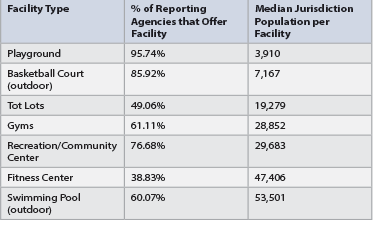 Park and recreation agencies throughout the country vary widely from one another, each with their own unique qualities and characteristics. Whether it’s staff size, organizational structure, program services offered or population demographics, it can safely be concluded that no two agencies are exactly the same. However, one of the greatest common denominators among almost all agencies is the operation of playground facilities. Data from PRORAGIS™ shows that approximately 96 percent of park and recreation agencies offer playground facilities, almost all of which are at no cost to the public.
Park and recreation agencies throughout the country vary widely from one another, each with their own unique qualities and characteristics. Whether it’s staff size, organizational structure, program services offered or population demographics, it can safely be concluded that no two agencies are exactly the same. However, one of the greatest common denominators among almost all agencies is the operation of playground facilities. Data from PRORAGIS™ shows that approximately 96 percent of park and recreation agencies offer playground facilities, almost all of which are at no cost to the public.
The nearly universal operation of playgrounds among park and recreation agencies can be attributed to the many demonstrable positive impacts that such facilities have on communities and citizens. The beneficial health effects of play in playground facilities are experienced as children engage in physical exercise in activities like climbing ladders, kicking their legs on swings and traversing obstacle courses. Playgrounds also allow for the chance to develop social skills among children through imaginative play, sharing and interaction with peer groups; similarly, parents of children have opportunities to meet people and create new friendships in a unique social setting. In many instances, playgrounds provide access for children and families to play places, green spaces and community activities that would otherwise be unavailable without park and recreation agencies.
Previous issues of this magazine have showcased a number of innovative playground facilities that are working to provide even more positive impacts. Whether it’s inclusive facilities that are specifically designed to promote playground access to children and adults of all physical and mental abilities, or nature play areas developed to connect children to diverse elements and organisms in nature, many park and recreation agencies are at the forefront of exciting advances in the way communities play.
Not only do most park and recreation agencies operate playgrounds, but each playground also generally serves a smaller population than other facilities. In 2013, of agencies that provided information, the data shows that the median population per playground was 3,910 individuals. Out of context, this figure is nondescript, but when comparing facility usage by facility type (particularly for facilities that are available most commonly among all reporting agencies — see table), the data shows that playgrounds tend to be more common and serve smaller populations.
As your agency thinks about its playgrounds, be it to access the impact of your current facilities or to plan for a future innovative playground, use PRORAGIS to help meet your evaluation needs. PRORAGIS can provide data that will allow you to compare your playground and facility needs against those of your peers, and can provide you with valuable data to achieve your operational goals.
David Kurtz is NRPA’s Research Specialist.

